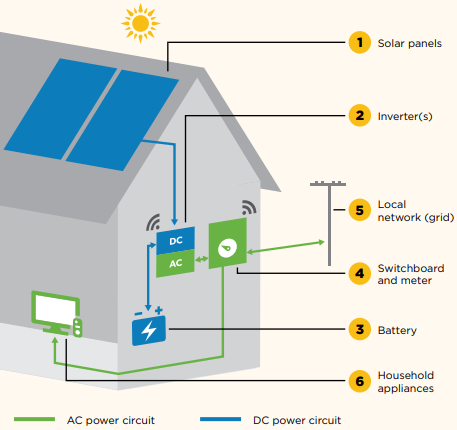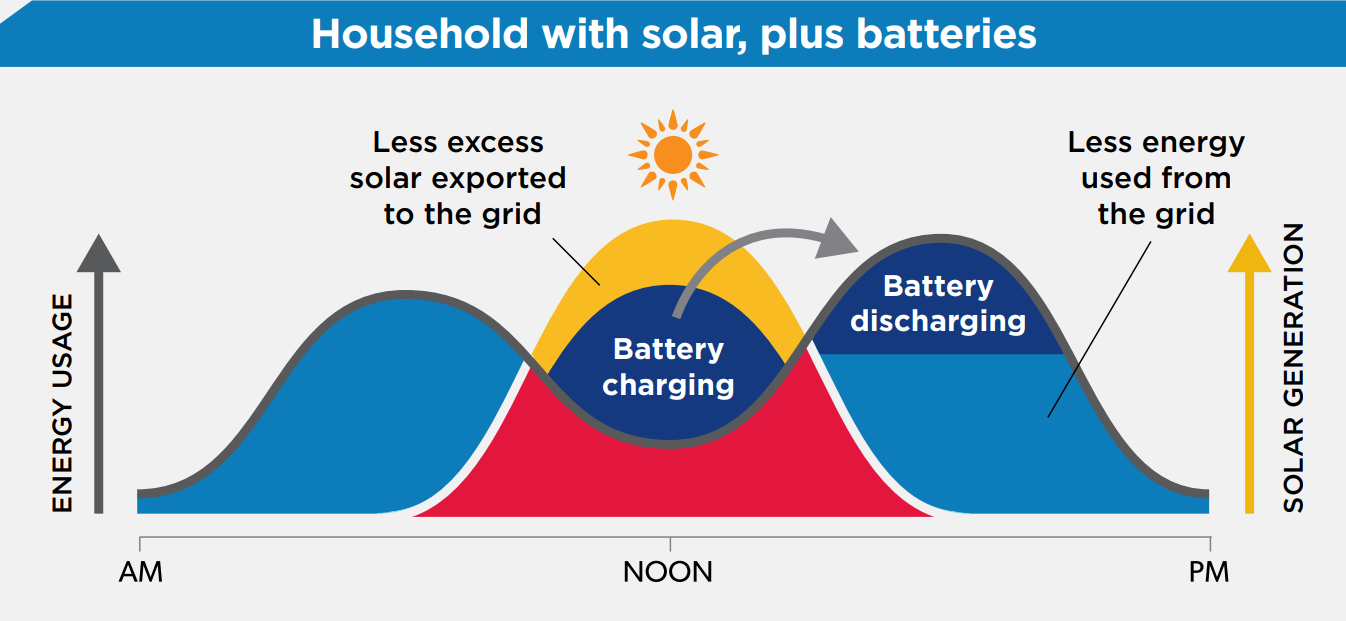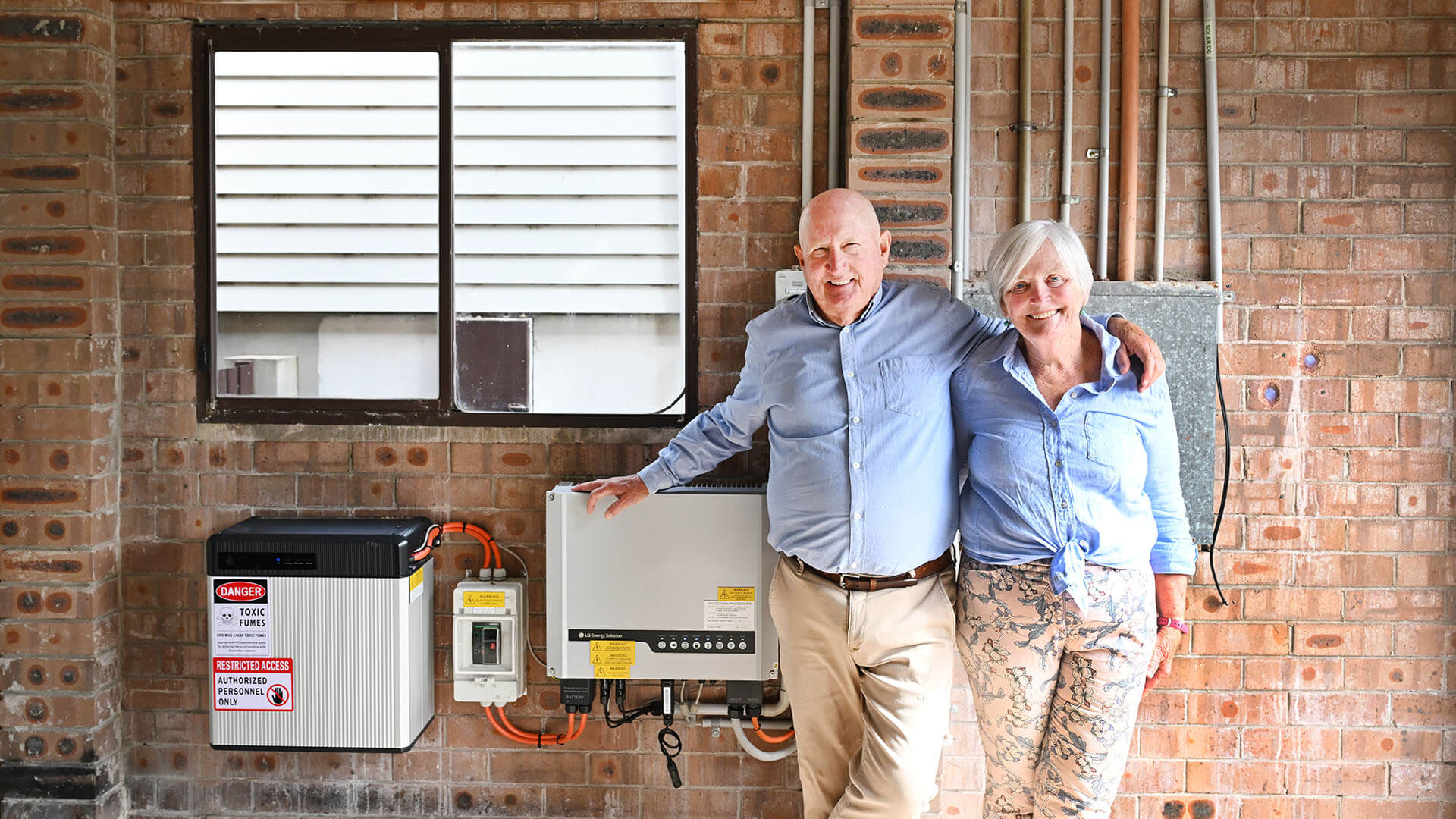This guide provides important information to help you decide whether installing a battery is right for you and how to get the most out of one.
Battery incentives are available to NSW residents. These will enable eligible premises to receive an incentive when installing a battery and for connecting a battery to a Virtual Power Plant (VPP), provided that an accredited supplier is offering these services in your area.
You should read this guide before taking advantage of these incentives and deciding whether to install a battery on your premises.
Installing more batteries across NSW will help make the grid more reliable and stable, while also reducing our reliance on fossil fuels. This will help reduce NSW’s emissions by 70% by 2035 and achieve net zero by 2050.
How solar and battery systems work
While solar panels can generate electricity when sunlight is available, they can’t continue powering your home or business once the sun goes down. Installing a battery allows the excess energy generated from solar panels to be stored and used outside of daylight hours, reducing the need to use electricity from the network (known as the grid). This is particularly useful during times of high demand, which often occurs in the evening when prices rise and fossil fuel-based electricity production increases.
The main components of a solar and battery system

- Solar panels: convert sunlight into direct current (DC) electricity, which charges the battery.
- Inverter(s): manages the flow of electricity, converting the electricity generated from the solar panels into alternating current (AC), the type of electricity that powers your home.
- Battery: stores excess electricity generated by solar panels.
- Switchboard and meter: the switchboard distributes electricity to your home. Your smart meter measures electricity flows to and from the grid.
- Local network (grid): provides electricity when your battery is not in use or empty, and your solar panels are not producing electricity. Your excess solar electricity can also be fed back to the grid.
- Household appliances: many appliances can be scheduled to run only when you have excess solar power, helping to reduce the energy used from the grid.
Benefits of installing a battery
Installing a battery can bring your home or business great benefits. These won't be the same for all premises and will vary based on energy consumption and solar panel and battery capacity.
A solar and battery system can help reduce the amount of energy you buy from the grid, allowing you to use your excess solar energy even when the sun is down.

In addition to producing and storing your own electricity, there are other benefits from solar and battery systems.
Lowering the cost of running your appliances or heating and cooling your home at night or during peak electricity times, by storing and using the energy your solar system generates when the sun is shining.
Reducing the use of fossil fuels needed to generate electricity in the evening.
Lowering NSW’s evening electricity demand will reduce the need for new power generation and distribution infrastructure.
Connecting your battery to a Virtual Power Plant (VPP) can provide you a payment for discharging energy in your battery when the grid needs it most. This incentive can speed up the time it takes to pay back the upfront cost of your solar and battery system.
Things to consider before installing a battery
Installing a battery is a big decision. We recommend you take the time to get multiple quotes and read the available resources to help you choose a reputable installer and the right battery for you.
Select a professional installer, or installation company, with a good reputation. Ensure they are, or use, qualified tradespersons by checking that their electrical tradesperson licence appears on the Service NSW website. You should also check that they are accredited by Solar Accreditation Australia (SAA) to install batteries.
Lithium-ion batteries are the most common type of battery technology used in solar battery installations. There are 2 main types of lithium-ion batteries, nickel manganese cobalt (NMC) and lithium iron phosphate (LFP). In most cases, you will need to look up whether a battery is NMC or LFP, as most fact sheets will only state ‘lithium-ion’. NMC type batteries are widely used in electric vehicles and in-home battery systems. In recent years the industry has started to shift towards LFP due to its longevity, which may make it cheaper to purchase, though good quality options can be found for both types.
Consult with your installer to choose a battery best suited to your energy needs and existing solar system. When comparing batteries, consider the warranty terms, brand reputation and consumer reviews. You can find suitable batteries accredited by a reputable industry body like the Clean Energy Council (CEC). For the battery installation incentive, the eligible batteries will be a selection of this list that meets certain requirements.
The battery’s warranty is critical for your protection and must meet a certain standard if you want to take advantage of the battery incentives. An in-depth guide to battery warranties can be found below.
Homes that use more energy during the late afternoon and evening will benefit the most from installing a battery. Homes that already use most of the energy produced by their solar panels, for example running appliances when the sun is shining, will see fewer savings from installing a battery. A reputable installer, such as one approved by Solar Accreditation Australia (SAA), will be able to help you interpret your energy use. You may also wish to use a tool such as SunSpot to estimate the savings achieved by adding a battery to your solar system.
You need to weigh up the upfront investment with the projected long-term savings for your situation and desire to capitalise on the other benefits of batteries, such as lower carbon footprint, higher grid independence, and resilience to blackouts.
Most homes with solar will already have a smart meter installed. If you don’t have one, your electricity retailer will provide one free of charge shortly after you install a solar system.
Homes with an outdated switchboard may need an upgrade to prepare for the installation of a solar and battery system. This can be quoted by an independent electrician or factored into your solar and battery quote if your chosen installer offers this service.
Although homes with solar will already have an inverter, some sites may require replacement of the existing inverter with one that is compatible with a battery. More details on inverters can be found below.
Inverter and battery compatibility
Ensuring compatibility between your inverter and battery is crucial to the efficient operation of your solar battery system. Homes with solar panels will already have an inverter, though some may require replacement of the existing inverter with one compatible with the battery. We recommend considering the below key points.
Before installing a new battery, ensure that your existing inverter is compatible. Your installer can provide guidance on this, but it is essential to confirm that the battery recommended by the installer is listed as compatible by the inverter manufacturer. This can prevent unnecessary costs and potential warranty issues. Some manufacturers offer inverter compatibility statements online that list batteries approved for use with an inverter.
Your installer is responsible for ensuring compliant design and compatibility, so we recommend you question them on this.
Using a battery and inverter that are not compatible can void the warranties for both components. Always verify compatibility to protect your investment.
Battery safety
Safety is very important when installing and operating batteries. When all guidelines and regulations are followed, the risk of a battery causing a fire is very low. Here are 5 simple steps you can take to ensure that you receive a high-quality installation and safely operate and maintain your battery.
Check your installer has current accreditation here. Get their advice to decide on a high-quality battery from a recommended manufacturer. Remember to shop around.
Consult your installer to select the installation location. The decision should consider bushfire and flooding risk, as well as internal factors, such as storage of fuels and chemicals nearby. Where possible, the battery should be installed away from habitable rooms, and ideally in utility areas such as garages, when protected by a bollard, or outside. Safety should always take precedence over appearance when positioning the battery.
It is recommended that your installer places a smoke detector near the battery. This will provide an alert for a potential battery fire or smoke from a fire elsewhere on the premises. If utilising the battery installation incentive a smoke alarm is required for indoor installations.
Read the battery manual and follow all guidelines from both the manufacturer and installer.
Check your battery for signs of damage, strange sounds or gases. Avoid anything that hinders ventilation, such as storing items too close or allowing leaves to pile up around the battery.
Fire & Rescue NSW have published dedicated battery safety information that we recommend you familiarise yourself with.
Warranties
As with any product, batteries degrade over time. This is a normal process and can’t be avoided. Manufacturers offer a range of warranties to guarantee performance for a certain period of time.
Many battery manufacturers offer a 10-year product warranty. However, the warranty terms can be shorter depending on the type of battery, its storage capacity and how it is used. Manufacturers can express the terms of their warranties in different ways, which can make comparison difficult. We recommend investigating the following when choosing a battery.
Manufacturers may guarantee a fixed term in years (e.g. 10 years) or a set number of cycles over a battery’s lifetime, whichever comes first. A cycle refers to the number of times a battery is completely charged and discharged, often a daily occurrence for NSW households. For example, a battery that is warranted for 4,000 cycles equates to approximately 11 years (4,000 cycles / 365 days = 10.96 years).
Some manufacturers define a total amount of energy that the battery is warranted to discharge. This is often stated in terms of megawatt-hours (MWh). Similar to cycle warranties, throughput warranties typically only apply if your battery reaches its throughput limit within the warranty time period.
This is a guarantee that your battery will retain a certain amount of capacity throughout the warranty period. For example, many manufacturers guarantee that 70% of a battery’s original capacity will remain after 10 years.
Be sure to check what is covered in the warranty before choosing your battery and talk to your installer about any warranty limitations and exceptions that may apply, including conditions of operation.
Other technical terms often used by manufacturers in product warranties include:
This term describes how deeply the battery is discharged. If a battery has delivered 90% of its energy, and 10% energy is reserved, the DoD of this battery is 90%. For lithium-ion batteries, the DoD is typically 90-95% to maximise battery life.
This is the capacity of the battery that can be regularly discharged. For example, a typical 14 kWh battery has a usable capacity of 13.5 kWh.
The optimal ambient temperature range at which the battery can function without changes to power output or capacity.
The ambient temperature range in which your battery will remain covered by the manufacturer’s warranty.
Virtual Power Plants (VPPs)
Electricity prices increase significantly when more homes use more energy at the same time. With an eligible battery, you may be able to sell some of the energy stored in your battery to the grid when prices are high. This can be done remotely by companies that you enter a contract with.
When many homes do this, the network of batteries is called a Virtual Power Plant (VPP). VPPs support the grid to keep everybody’s lights on and lower reliance on fossil fuels by utilising solar when it’s needed most by the grid.
Signing up with a VPP will mean your battery is occasionally discharged as required by the grid. The terms of this arrangement are between yourself and the VPP operator, so please read all contract terms and conditions carefully.
There are several VPPs already operating in NSW, mostly associated with electrical retailers. However, you'll need to wait until businesses become accredited to access this incentive and have them pass it through to you. Find out more here.
Off-grid systems
If a grid connection is expensive or if grid independence is desired, an off-grid battery system may be appropriate. Off-grid systems are typically more expensive to install than grid-connected systems as they require more solar panels and a larger battery. The benefits of going off-grid include enjoying 100% renewable electricity and avoiding both grid outages and grid electricity charges.
There are several schemes aiming to reduce demand on the electricity network, and therefore are only available to sites connected to the grid. There are no incentives to reduce the costs for off-grid battery systems.
More battery information
These resources can help you take the next steps in preparing to install a battery at your premises.
Further solar and battery system information
You can find more detailed information on solar and battery systems at the following websites:
- Clean Energy Council (CEC) - guide to installing a household battery storage system
- New Energy Tech Consumer Code (NETCC) - guide to installing battery storage
- Solar Victoria - battery systems and components
- Australian Government - solar and batteries
Glossary
AC | Alternating current |
DC | Direct current |
DoD | Depth of discharge |
kWh | Kilowatt-hour (1000 kWh = 1 MWh) |
LFP | Lithium ferrophosphate, or Lithium Iron Phosphate |
MWh | Megawatt-hour (1 MWh = 1000 kWh) |
NMC | Nickel Manganese Cobalt |
NSW | New South Wales |
PDRS | Peak Demand Reduction Scheme |
SAA | Solar Accreditation Australia |
VPP | Virtual Power Plant |
Additional energy saving measures
If you've decided that a battery isn't for you, there are several other steps you can take to minimise your energy consumption and bills.
Find out about other NSW Government incentives on offer and some more tips below.
Replace old light bulbs with LEDs, switch off appliances and lights when not in use, use less hot water, have shorter showers and wash clothes in cold water. Find out more ways you can less energy and save on your energy bills.
Insulation can help you use less energy on heating and cooling. Good building insulation, like ceiling batts, can help you recover its upfront costs from electricity saved faster than either solar systems or batteries.
Always check the energy rating labels when you are shopping for a new appliance. Energy efficient appliances, with at least four stars on their Energy Rating label, may cost less over the life of the product, despite a higher upfront cost. There are a range of incentives to help reduce the cost of energy-efficient upgrades, including for:
If you are on a time of use tariff with your power supplier, look at options to consume your energy outside of peak times. For example, running the washing machine when a cheaper tariff is available, such as during the middle of the day.
If you have existing solar, run appliances when there is sunlight, pre-heat your house (in winter) or pre-cool your house (in summer).
Use these to cover more of your consumption in the evening and early morning. You could also receive a feed-in tariff payment for solar power exported to the grid.
Find the most competitively priced retailer to help you save money on electricity. Ask for discounts for direct debit or on-time payments. Visit energyswitch.service.nsw.gov.au to help find the most competitive offer.
Visit energysaver.nsw.gov.au for more tips on how to fine-tune the energy used in your home and save money on your power bills.
